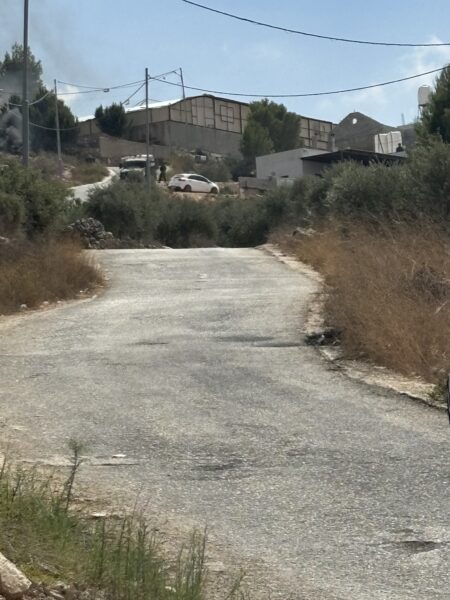
September 10, 2024 – For immediate release
Media inquiries: ismtraining [at] riseup.net
On Friday, September 6, Turkish-American human rights activist with the International Solidarity Movement (ISM) Aysenur Eygi was killed by a single shot to the head from an Israeli sniper while witnessing a demonstration against the illegal Israeli settlement of Evyatar on Beita’s lands. After a brief internal investigation conducted by the Israeli army itself, the Israeli army has released a statement asserting that “the inquiry found that it is highly likely that she was hit indirectly and unintentionally by IDF fire which was not aimed at her.” The ISM entirely rejects this specious claim and continues to demand an independent investigation of the Israeli army’s killing of our comrade Aysenur Eygi. ISM is joined in this demand by people worldwide who have watched Israel operate with impunity for decades. The world sees through this transparent attempt to conceal the Israeli army’s responsibility for the death of Aysenur Eygi, who is just one of the hundreds of thousands of martyrs Israel has killed over decades of ethnic cleansing, displacement, and genocide.
The military’s account of the events is blindly based on the accomplices’ version, which completely contradicts the testimonies of multiple eyewitnesses, who the military did not even contact. All eyewitnesses said immediately following the killing that the scene where Aysenur was killed was completely quiet and that there could have been no excuse to open fire, let alone directly hitting a woman peacefully standing in an olive grove.
According to activists who were present when Aysenur was killed, the Israeli army’s brief statement “includes an array of evident falsehoods, clearly indicating how its investigation is concerned with deflecting fault and avoiding any sort of accountability.” These falsehoods include:
- The military version claims Aysenur was not the target of the kill-shot, but rather that she was hit “indirectly and unintentionally” when a soldier targeted a key instigator. This statement does not align with the physical reality on the ground for several reasons:
- It is unclear what the claim that Aysenur was hit “indirectly” is based on, as there is no forensic evidence to back this up this claim.
- The closest Israeli forces to where Aysenur was when she was shot, were those positioned on a rooftop some 750 feet (220m) away from her, at an elevated position. Considering the distance and the soldiers’ elevation, stones could not have physically been thrown towards the soldiers from the location Aysenur was at when she was shot.
- There were two separate shots fired, with a few seconds in between them. The first shot hit a metal object and shrapnel hit a Palestinian teenager in the pelvis. Had there been any truth to the military’s false narrative of confrontations taking place where and when Aysenur was shot, reason would have it that he was the main instigator the statement is referring to. However, Aysenur was hit by a second shot, several seconds after the teenager was already down. It was aimed directly at her, as there was no one else around (besides an activist standing next to her) who could have been the target of the shot.
- The teenager was located further away to the side from the soldiers than Aysenur, so a shot aimed at him could not have possibly hit her, directly or indirectly.
- The statement very manipulatively conflates two events that are separate in time and place. The first event was the one during which short confrontations took place soon after the midday prayer at the top of the hill. It was then and there that a few burning tires were placed on the road. The second event is the shooting of Aysenur, which took place more than half an hour later – when there were no confrontations at all – more than 900 feet (274m) from where the burning tires were, and about 750 feet (220 m) from the rooftop where the soldier who shot her was positioned in an elevated, tactically controlling position.
- Aysenur was not shot at the Beita Junction. The Beita Junction is here, while she was shot here. The two locations are more than a mile away from each other (1.16 miles, 1.87km).
The Israeli army has a long history of using sham investigations as a method of covering up their human rights abuses and crimes against humanity in Palestine. According to Israeli human rights group B’Tselem, from a report published jointly with the Palestine Centre for Human Rights, Israel has long been “unwilling and unable” to investigate its soldiers for attacking peaceful protesters. This history of fake investigations as cover-ups goes back decades and has been documented by B’Tselem and other human rights groups.
When ISM activist Rachel Corrie was killed by the Israeli army in Gaza in 2003, a similar sham investigation swiftly cleared the Israeli forces of all responsibility. Rachel Corrie’s parents have spoken out, demanding a thorough investigation into this case. Warning about another coverup, they have said clearly that if an independent, truthful investigation had been conducted 21 years ago, many lives that have been taken by Israel in the ensuing decades could have been saved. Even U.S. Secretary of State Anthony Blinken has said “The killing of the American activist in the West Bank was unjustified and without provocation on her part, and it is not permissible to shoot someone because he participated in a demonstration.”
